1996 BUICK REGAL brake light
[x] Cancel search: brake lightPage 12 of 356
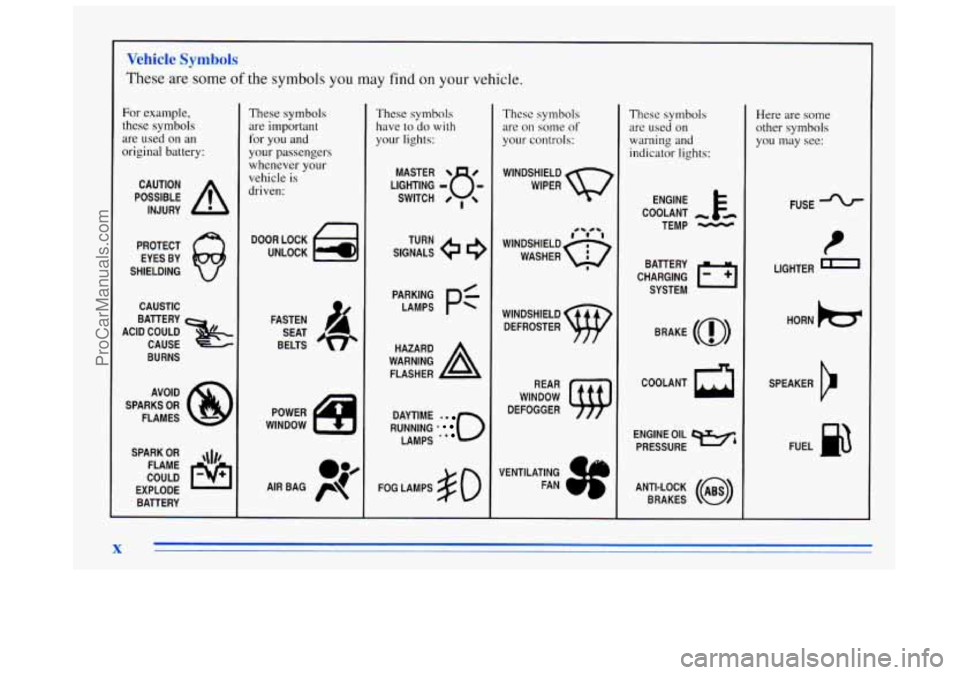
Ve hide bols
These are some of the symbols you may find on your vehicle.
For example,
these symbols
are used on an
original battery:
POSSIBLE A
CAUTION
INJURY
PROTECT EYES BY
SHIELDING
CAUSTIC
BURNS AVOID
SPARKS
OR
FLAMES
SPARK
OR ,\I/,
COULD FLAME
EXPLODE BATTERY
These symbols
are important
for you and
your passengers
whenever
your
vehicle is
driven:
DOOR LOCK
UNLOCK
FASTEN SEAT
BELTS
POWER
WINDOW
These symbols have to do
with
your lights:
SIGNALS e
TURN
RUNNING
* 0
DAYTIME ..
LAMPS .*
FOG LAMPS # 0
These symbols
are
on some of
your controls:
WINDSHIELD
WIPER
WINDSHIELD DEFROSTER
WINDOW
DEFOGGER
VENTILATING FAN
1 d J
These symbols
are used on
warning and
indicator lights:
ENGINE F-
COOLANT -
TEMP -
CHARGING I-1
BAllERY
SYSTEM
BRAKE
(a)
COOLANT a
ENGINE OIL e,
PRESSURE
ANTI-LOCK
(@)
BRAKES
Here are some
other symbols
you may see:
FUSE
t
LIGHTER n
HORN hs
SPEAKER
b
FUEL p3
ProCarManuals.com
Page 75 of 356
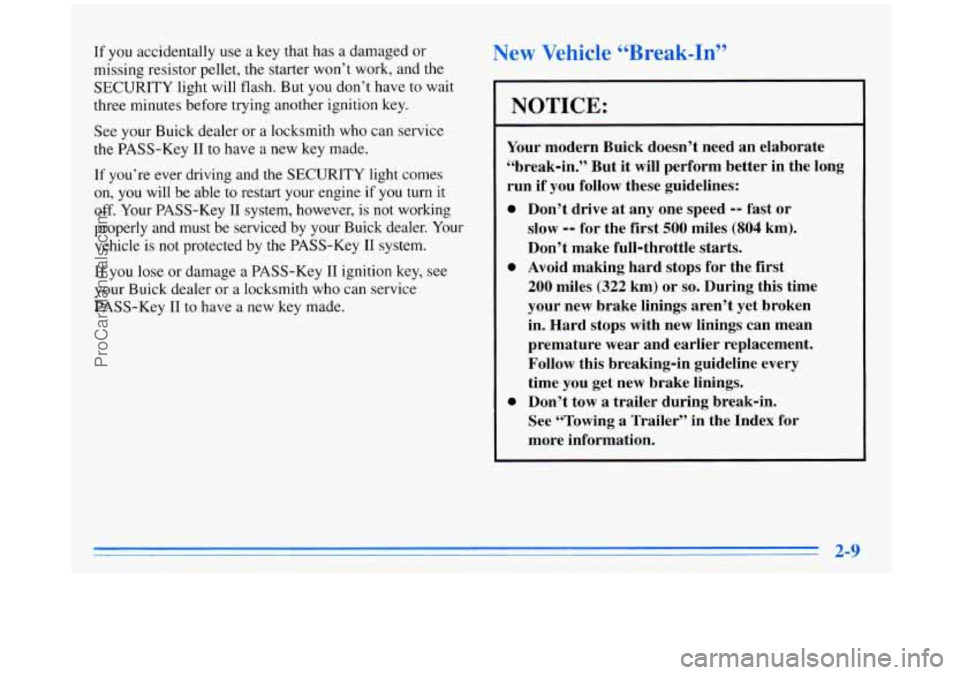
If you accidentally use a key that has a damaged or
missing resistor pellet, the starter won’t work, and the
SECURITY light will flash. But you don’t have to wait
three minutes before trying another ignition key.
See your Buick dealer
or a locksmith who can service
the PASS-Key
I1 to have a new key made.
If you’re ever driving and the SECURITY light comes
on, you will be able to restart your engine if you turn it
off. Your PASS-Key I1 system, howevcr, is not working
properly and must be serviced by your Buick dealer. Your
vehicle is not protected by the PASS-Key I1 system.
If you lose or damage a PASS-Key I1 ignition key, see
your Buick dealer or a locksmith who can service
PASS-Key I1 to have a new key made.
New Vehicle CCBreak-InSS
NOTICE:
Your modern Buick doesn’t need an elaborate
“break-in.” But it will perform better in the long
run if you follow these guidelines:
0 Don’t drive at any one speed -- fast or
slow -- for the first 500 miles (804 km).
Don’t make full-throttle starts.
200 miles (322 km) or so. During this time
your new brake linings aren’t yet broken
in. Hard stops with new linings can mean
premature wear and earlier replacement.
Follow this breaking-in guideline every
time you get new brake linings.
See “Towing
a Trailer’’ in the Index for
more information.
0 Avoid making hard stops for the first
0 Don’t tow a trailer during break-in.
ProCarManuals.com
Page 96 of 356

Resuming a Set Speed
Suppose you set your cruise control at a desired speed
and then
you apply the brake. This, of course, shuts off
the cruise control. But you don’t need to reset it.
If you leave your cruise control switch on when
you’re not using cruise, you might hit
a button
and
go into cruise when you don’t want to.
You could be startled and even lose control.
Keep the cruise control switch
OFF until you
want to use
it.
1. Move the cruise control switch to ON.
2. Get up to the speed you want.
3. Push in the SET button
at the end of the lever
and release it. The
CRUISE light on the
instrument panel will
come on.
4. Take your foot off the
accelerator pedal.
WA (Resume/Accelerate)
for about half a second.
You’ll go right back up to
your chosen speed and
stay there.
Increasing Speed While Using Cruise Control
There are two ways to go ,to a higher speed:
Use the accelerator pedal to get to the higher speed.
Press the button at the end of the lever, then release
the button and the accelerator pedal. You’ll now
cruise at the higher speed.
0 Move the cruise switch from ON to WA. Hold it
there until you get up to the speed
you want, and
then release
the switch. To increase your speed in
2-30
11
ProCarManuals.com
Page 97 of 356
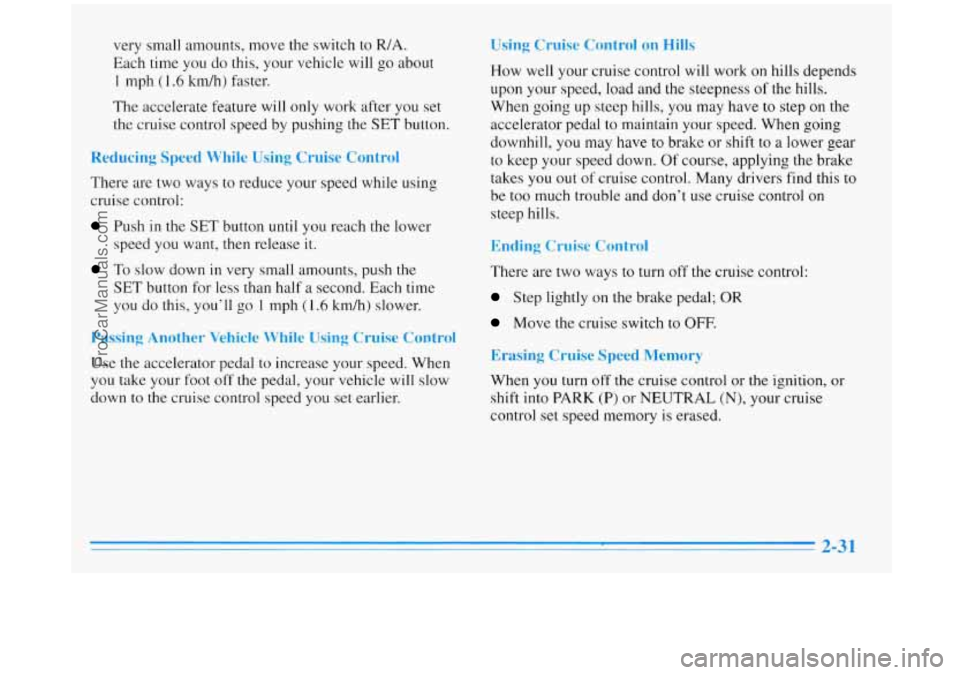
very small amounts, move the switch to R/A.
Each time you do this, your vehicle will go about
1 mph (1.6 kdh) faster.
The accelerate feature will
only work after you set
the cruise control speed by pushing the
SET button.
Reducing Speed While Using Cruise Control
There are two ways to reduce your speed while using
cruise control:
Push in the SET button until you reach the lower
speed you want,
then release it.
To slow down in very small amounts, push the
SET button for less than half a second. Each time
you do this, you’ll go
1 mph (1.6 kmh) slower.
Passing Another Vehicle While Using Cruise Control
Use the accelerator pedal to increase your speed. When
you take your foot off the pedal, your vehicle will slow
down to the cruise control speed you set earlier.
Using Cruise Control on Hills
How well your cruise control will work on hills depends
upon your speed, load and the steepness
of the hills.
When going up steep hills, you may have to step on the
accelerator pedal to maintain your speed. When going
downhill, you may have to brake or
shift to a lower gear
to keep your speed down.
Of course, applying the brake
takes you out
of cruise control. Many drivers find this to
be too much trouble and don’t use cruise control on
steep hills.
Ending Cruise Control
There are two ways to turn off the cruise control:
Step lightly on the brake pedal; OR
Move the cruise switch to OFF.
Erasing Cruise Speed Memory
When you turn off the cruise control or the ignition, or
shift into PARK (P) or NEUTRAL (N), your cruise
control set speed memory
is erased.
ProCarManuals.com
Page 98 of 356

Lamps
The lamp controls are on the instrument panel. They
control these systems:
Headlamps
Taillamps
Parking Lamps
License Lamps
0 Sidemarker Lamps
0 Instrument Panel Lights
0 .Courtesy Lamps Turn
the knob
to ON to turn on the headlamps and other
operating lamps.
Turn the knob to
PARK to turn on the parking and other
operating lamps without the headlamps.
Turn the knob to
OFF to turn off the lamps.
A warning chime will sound when you turn the ignition
switch to
OFF, LOCK or ACC with the lamps on.
Daytime Running Lamps (Option)
Daytime Running Lamps (DRL) can make it easier for
others to see the front
of your vehicle during the day.
DRL can be helpful in many different driving
conditions, but
they can be especially helpful in the
short periods after dawn and before sunset.
A light sensor on top of the instrument panel makes the
DRL work, so be sure it isn’t covered.
The DRL system will make your low-beam headlamps
come on at a reduced brightness when:
0 The ignition is on,
The headlamp switch is off, and
The parking brake is released.
2-32
ProCarManuals.com
Page 99 of 356
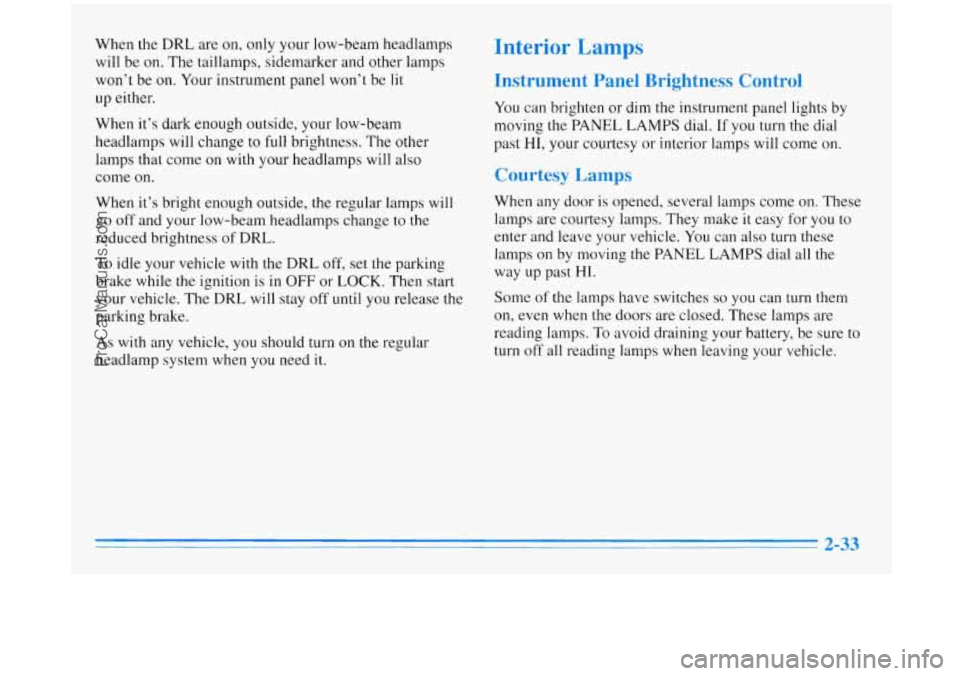
When the DRL are on, only your low-beam headlamps
will be on. The taillamps, sidemarker and other lamps
won’t be on. Your instrument panel won’t be lit
up either.
When it’s dark enough outside, your low-beam
headlamps will change to
full brightness. The other
lamps that come on with your headlamps will also
come on.
When it’s bright enough outside, the regular lamps will
go off and your low-beam headlamps change to the
reduced brightness of DRL.
To idle your vehicle with the DRL off, set the parking
brake while the ignition
is in OFF or LOCK. Then start
your vehicle. The DRL will stay off until you release the
parking brake.
As with any vehicle, you should turn on the regular
headlamp system when you need it.
Interior Lamps
Instrument Panel Brightness Control
You can brighten or dim the instrument panel lights by
moving
the PANEL LAMPS dial. If you turn the dial
past
HI, your courtesy or interior lamps will come on.
Courtesy Lamps
When any door is opened, several lamps come on. These
lamps are courtesy lamps. They make
it easy for you to
enter and leave your vehicle. You can also turn these
lamps on by moving the PANEL LAMPS dial all the
way up past
HI.
Some of the lamps have switches so you can turn them
on, even when the doors are closed. These lamps are
reading lamps.
To avoid draining your battery, be sure to
turn
of€ all reading lamps when leaving your vehicle.
ProCarManuals.com
Page 114 of 356
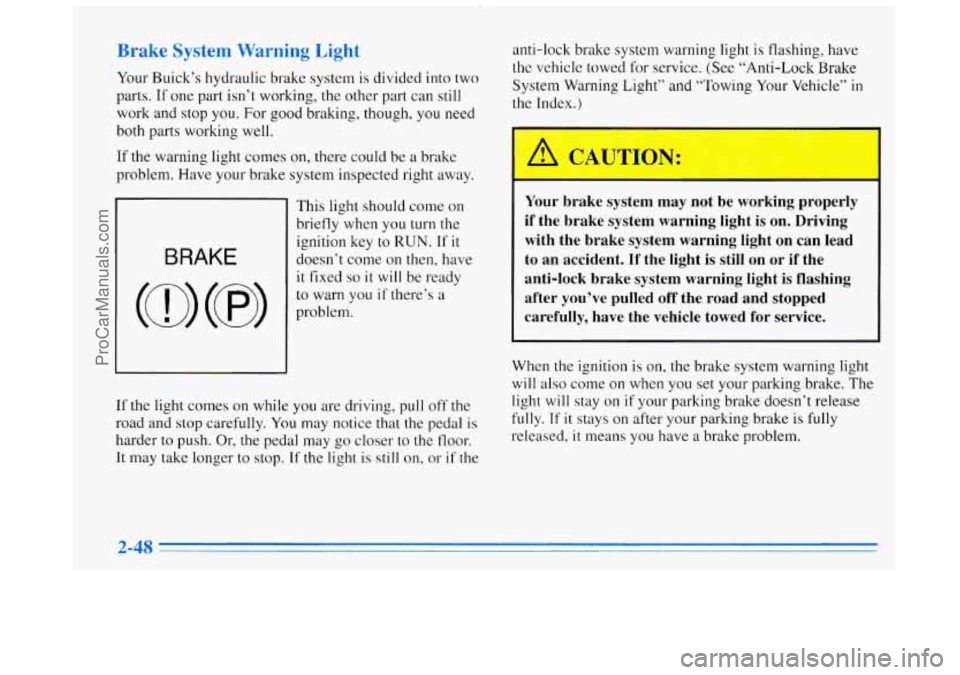
Brake System Warning Light
Your Buick’s hydraulic brake system is divided into two
parts.
If one part isn’t working, the other part can still
work
and stop you. For good braking, though, you need
both parts working well.
If the warning light comes on, there could be a brake
problem. Have your brake system inspected right away.
BRAKE
This light should come on
briefly when you turn the
ignition key to
RUN. If it
doesn’t come on then, have
it fixed so it will be ready
to warn you if there’s
a
problem.
If the light comes on while you are driving, pull off the
road and stop carefully.
You may notice that the pedal is
harder to push. Or, the pedal may go closer to the floor.
It may take longer to
stop. If the light is still on, or if the anti-lock brake system warning light
is flashing, have
the vehicle towed for service. (See “Anti-Lock Brake
System Warning Light”
and “Towing Your Vehicle” in
the Index.)
Your brake system may not be working properly
if the brake system warning light is on. Driving with the brake system warning light on can lead
to an accident. If the light
is still on or if the
anti-lock brake system warning light
is flashing
after you’ve pulled off the road and stopped
carefully, have the vehicle towed for service.
When the ignition is on, the brake system warning light will also come on when you set your parking brake. The
light will stay on
if your parking brake doesn’t release
fully. If it stays 011 after your parking brake is fully
released,
it means you have a brake problem.
ProCarManuals.com
Page 115 of 356
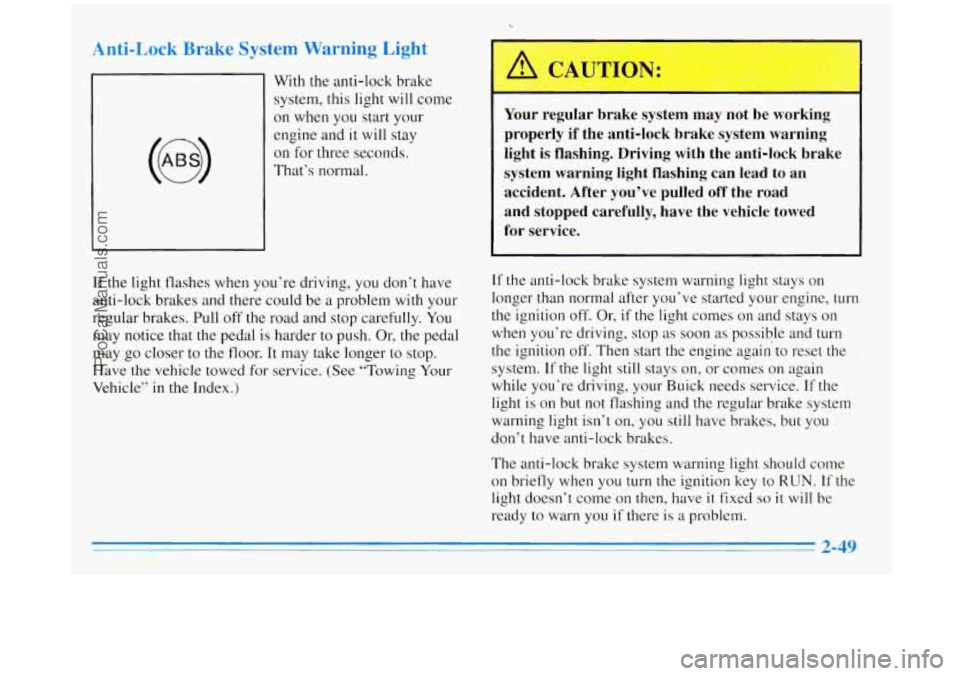
Anti-Lock Brake System Warning Light
With the anti-lock brake
system, this light will come
on when you start your
engine and
it will stay
on for three seconds.
That’s normal.
If the light flashes when you’re driving, you don’t have
anti-lock brakes and there could be a problem with your
regular brakes. Pull off the road and stop carefully.
You
may notice that the pedal is harder to push. Or, the pedal
may go closer to the
floor. It may take longer to stop.
Have the vehicle towed for service. (See “Towing Your
Vehicle” in
the Index.)
A
Your regular brake system may not be working
properly if the anti-lock brake system warning
light
is flashing. Driving with the anti-lock brake
system warning light flashing can lead
to an
accident. After you’ve pulled off the road and stopped carefully, have the vehicle towed
for service.
f the anti-lock brake system warning light stays on
longer than normal after you’ve started your engine, turn
the ignition off. Or, if the light comes
on and stays on
when you’re driving, stop as soon as possible and turn
the ignition
off. Then start the engine againto reset the
system.
If the light still stays on, or comes on again
while you’re driving, your Buick needs service. If the
light is
on but not flashing and the regular brake system
warning light isn’t on, you still have brakes, but you
don’t have anti-lock brakes.
The anti-lock brake system warning light should come
on briefly when you turn the ignition key
to RUN. If the
light doesn’t come on then, have
it fixed so it will be
ready to warn you if there is a problem.
2-49
ProCarManuals.com